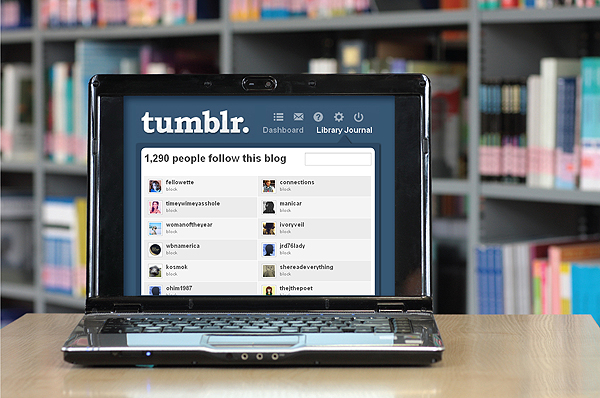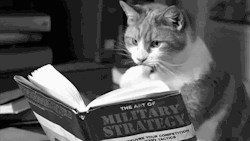
Tumblr got me a job.
Being intimidated by the prospect of a “full-size” blog, I joined Tumblr in February 2011. Since then I’ve shamelessly promoted my “name” and stalked down as many libraries/librarians on the site as I could find. I’ve connected with libraries, librarians, library students, publishers, writers, readers, Doctor Who fanatics, and cat lovers. I even linked up with LJ and got to write my first “Backtalk” piece.
Days later, my now current employer reached out after reading the piece, complimented my writing, and told me about an opening at their company. I was in immediately for an interview, and a week or so after that, received an offer. Just like that, I’m a working librarian.
It’s an example of social media at its best and most useful. I can’t promise Tumblr will get you a job, but I can bet you’ll find a welcoming, engaged community of bloggers open to new ideas, lively conversation, and real-life friendships.
Get Started with These Library Tumblrs
- Brentwood Library (NY)
- Chicago Public Library
- Darien Library (CT)
- Espresso Book Machine at the Brooklyn Public Library
- Forest Park Library (IL)
- George Peabody Library’s Wunderkammer! (MD)
- Hennepin County Public Library (MN)
- Librarian Problems
- Library Journal
- MoMA Library
- New York Public Library
- Nova Scotia Archives
- Queens Library
- Que(e)ry (NY)
- Ransom Center (TX)
- School Library Journal
- This Is What a Librarian Looks Like
Tumblr is a microblogging platform where bloggers post text, links, quotes, audio clips, videos, and images to a community of followers and outside readers. These posts can be commented on, “liked,” or “reblogged” by other Tumblr users. In terms of blog size and scope, think of Tumblr as falling somewhere between Twitter and traditional blogs like Blogspot or WordPress. Tumblr users create their own blog in order to follow and be followed by other bloggers. Then, similar to Twitter, posts made by other users you follow will show up on a constantly updated “dashboard.”
Tumblr is currently a community of over 60 million users. This includes major publishers, independent presses, authors, libraries, librarians, readers, students, and teachers. Library Journal is even among the crowd. “Tumblr is your global cocktail party, from big influencers to young fans,” says Rachel Fershleiser, who heads up literary and nonprofit outreach for Tumblr. Tumblr is full of communities and fandoms—groups of bloggers who rally around certain interests and issues.

Typical Tumblr user.
Like the rest of the internet, it’s also full of crazies, kittens, and mature content. But unlike traditional blogging, in which you create a post and hope someone out there might read it, Tumblr posts have a built in audience (your followers) and can be easily and quickly shared. Through the reblogging feature, your posts can reach hundreds (even thousands) of readers in only a few clicks.
The advantage for individual librarians (and library students) is that you can link up with enthusiastic communities of other professionals in libraries, archives, education, nonprofit, and corporate sectors. You can even bring library news to people who aren’t librarians! It’s a great place to create a name, or a brand, for yourself. For libraries, Tumblr is a free marketing tool—and depending on how much effort you want to put into crafting code or purchasing a theme, your Tumblr blog can look as professional as a your library’s website.
There are some specific steps you can take to attract an engaged readership (i.e. followers). It can be a slow first few months as you accumulate an audience and discover where you fit into the community, but the investment is worth it. Here’s a few guidelines to consider:
No whining, just follow.
Seek out great blogs to follow! Whether or not they’re related to the purpose of your own blog, they may give you some great ideas on how to focus your content, format your blog, and develop post ideas. You can search Tumblr by keyword or by featured tags to find different blogs. Engage with posts and bloggers you connect with through the like, reblog, and reply features.
Complaining about your lack of followers in unread posts will not gain you more followers. Pay attention to what posts go viral in the Tumblr community and follow suit if you find the opportunity. There’s no shame in baiting new followers with a beloved author quote or topical GIF. Use what you learn from other blogs to gain momentum and establish a following.
Be yourself and balance your content
Tumblr and other microblogging platforms are enjoyable because posts can be composed at a moment’s notice. There’s even a bookmarklet feature that allows bloggers to post as they’re browsing other parts of the web. However, this does not mean that your followers and the greater library world want to see an Instagram of what you have for lunch every day (at least, not every day). Some of the best blogs for libraries or librarians find a natural balance between the personal and professional. Readers like to know the person behind the blog. Even if you are keeping up a Tumblr for your library, feel free to field questions and engage with other bloggers.
Vary the type and length of your posts—utilize the range of posting features (text, audio, video, etc.). Keep in mind best practices for reblogging posts and credit the original blogger. Be open to sparking discussion among your readers. Always consider that your posts are not only a part of your blog, but also the rest of the Tumblr, and wider web, community.
No tags, no readers.
Tumblr posts and blogs are best discovered by tagged content. There is no universal search within Tumblr for specific blogs or bloggers. Rather, users search by tagged topics of interest, just as users follow hashtags on Twitter. Without tags, your posts may go unread. Too many users compose brilliant posts on happenings in the library world, only to cast them out, untagged, into the internet abyss. These posts may only be read by followers, but they aren’t likely to be picked up by a wider audience unless they’re reblogged or properly tagged.
When tagging a post, consider the broader themes it might be relevant to, beyond #libraries and #librarians—i.e. #lit, #education, #history, #literacy, etc. Additionally, check up on these tags regularly to find great content posted by other bloggers. This is where a lot of great conversations, and eventually communities, get started.
If you think you’re ready to give Tumblr a try, check out this list of libraries/librarians and this list of archives/archivists. Try it out. Be patient. Most important, remember to interact with your community members, tag your posts, and keep reading. Happy Tumbln’!


Kate Tkacik is a recent Dominican University graduate living and working in Chicago. She can be followed at thelifeguardlibrarian.tumblr.com and reached at katetkacik@gmail.com



i am completely agree that Tumblr and other micro blogging platforms are enjoyable because posts can be composed at a moment’s notice..thanks for rest information.